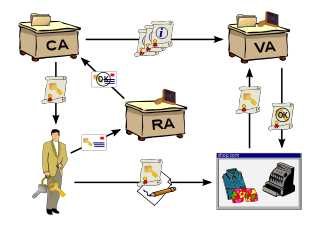Related Research Articles

Public-key cryptography, or asymmetric cryptography, is a cryptographic system that uses pairs of keys: public keys which may be disseminated widely, and private keys which are known only to the owner. The generation of such keys depends on cryptographic algorithms based on mathematical problems to produce one-way functions. Effective security only requires keeping the private key private; the public key can be openly distributed without compromising security.

Authentication is the act of proving an assertion, such as the identity of a computer system user. In contrast with identification, the act of indicating a person or thing's identity, authentication is the process of verifying that identity. It might involve validating personal identity documents, verifying the authenticity of a website with a digital certificate, determining the age of an artifact by carbon dating, or ensuring that a product or document is not counterfeit.

A virtual private network (VPN) extends a private network across a public network, and enables users to send and receive data across shared or public networks as if their computing devices were directly connected to the private network. Applications running on a computing device, e.g., a laptop, desktop, smartphone, across a VPN may therefore benefit from the functionality, security, and management of the private network. Encryption is a common, though not an inherent, part of a VPN connection.
Transport Layer Security (TLS), and its now-deprecated predecessor, Secure Sockets Layer (SSL), are cryptographic protocols designed to provide communications security over a computer network. Several versions of the protocols find widespread use in applications such as web browsing, email, instant messaging, and voice over IP (VoIP). Websites can use TLS to secure all communications between their servers and web browsers.

A public key infrastructure (PKI) is a set of roles, policies, hardware, software and procedures needed to create, manage, distribute, use, store and revoke digital certificates and manage public-key encryption. The purpose of a PKI is to facilitate the secure electronic transfer of information for a range of network activities such as e-commerce, internet banking and confidential email. It is required for activities where simple passwords are an inadequate authentication method and more rigorous proof is required to confirm the identity of the parties involved in the communication and to validate the information being transferred.

In cryptography, a public key certificate, also known as a digital certificate or identity certificate, is an electronic document used to prove the ownership of a public key. The certificate includes information about the key, information about the identity of its owner, and the digital signature of an entity that has verified the certificate's contents. If the signature is valid, and the software examining the certificate trusts the issuer, then it can use that key to communicate securely with the certificate's subject. In email encryption, code signing, and e-signature systems, a certificate's subject is typically a person or organization. However, in Transport Layer Security (TLS) a certificate's subject is typically a computer or other device, though TLS certificates may identify organizations or individuals in addition to their core role in identifying devices. TLS, sometimes called by its older name Secure Sockets Layer (SSL), is notable for being a part of HTTPS, a protocol for securely browsing the web.
The Domain Name System Security Extensions (DNSSEC) is a suite of Internet Engineering Task Force (IETF) specifications for securing certain kinds of information provided by the Domain Name System (DNS) as used on Internet Protocol (IP) networks. It is a set of extensions to DNS which provide to DNS clients (resolvers) cryptographic authentication of DNS data, authenticated denial of existence, and data integrity, but not availability or confidentiality.
In computer security, an attribute certificate, or authorization certificate (AC) is a digital document containing attributes associated to the holder by the issuer. When the associated attributes are mainly used for the purpose of authorization, AC is called authorization certificate. AC is standardized in X.509. RFC 5755 further specifies the usage for authorization purpose in the Internet.
FTPS is an extension to the commonly used File Transfer Protocol (FTP) that adds support for the Transport Layer Security (TLS) and, formerly, the Secure Sockets Layer cryptographic protocols.
In computing, Network Security Services (NSS) comprises a set of libraries designed to support cross-platform development of security-enabled client and server applications with optional support for hardware TLS/SSL acceleration on the server side and hardware smart cards on the client side. NSS provides a complete open-source implementation of cryptographic libraries supporting Transport Layer Security (TLS) / Secure Sockets Layer (SSL) and S/MIME. Previously tri-licensed under the Mozilla Public License 1.1, the GNU General Public License, and the GNU Lesser General Public License, NSS upgraded to GPL-compatible MPL 2.0 with release 3.14.
There are a number of security and safety features new to Windows Vista, most of which are not available in any prior Microsoft Windows operating system release.
This is a comparison of notable free and open-source configuration management software, suitable for tasks like server configuration, orchestration and infrastructure as code typically performed by a system administrator.
Secure messaging is a server-based approach to protect sensitive data when sent beyond the corporate borders and provides compliance with industry regulations such as HIPAA, GLBA and SOX. Advantages over classical secure e-mail are that confidential and authenticated exchanges can be started immediately by any internet user worldwide since there is no requirement to install any software nor to obtain or to distribute cryptographic keys beforehand. Secure messages provide non-repudiation as the recipients are personally identified and transactions are logged by the secure email platform.
Security Support Provider Interface (SSPI) is a Win32 API used by Microsoft Windows systems to perform a variety of security-related operations such as authentication.
Security patterns can be applied to achieve goals in the area of security. All of the classical design patterns have different instantiations to fulfill some information security goal: such as confidentiality, integrity, and availability. Additionally, one can create a new design pattern to specifically achieve some security goal.

gLite is a middleware computer software project for grid computing used by the CERN LHC experiments and other scientific domains. It was implemented by collaborative efforts of more than 80 people in 12 different academic and industrial research centers in Europe. gLite provides a framework for building applications tapping into distributed computing and storage resources across the Internet. The gLite services were adopted by more than 250 computing centres, and used by more than 15000 researchers in Europe and around the world.
IEC 62351 is a standard developed by WG15 of IEC TC57. This is developed for handling the security of TC 57 series of protocols including IEC 60870-5 series, IEC 60870-6 series, IEC 61850 series, IEC 61970 series & IEC 61968 series. The different security objectives include authentication of data transfer through digital signatures, ensuring only authenticated access, prevention of eavesdropping, prevention of playback and spoofing, and intrusion detection.
Fabasoft Folio Cloud is a cloud computing service developed by Fabasoft in Linz, Austria announced in April 2010. It focuses on enabling secure collaboration and is web-based with iOS and Android apps for use on mobile devices. The software is object-oriented and offers a wide range of sophisticated functionality for document management and global collaboration, which can be extended by specialist cloud applications. Fabasoft places a large amount of focus on usability and accessibility.
A whole new range of techniques has been developed to identify people since the 1960s from the measurement and analysis of parts of their bodies to DNA profiles. Forms of identification are used to ensure that citizens are eligible for rights to benefits and to vote without fear of impersonation while private individuals have used seals and signatures for centuries to lay claim to real and personal estate.“ Generally, the amount of proof of identity that is required to gain access to something is proportionate to the value of what is being sought." It is estimated that only 4% of online transactions use methods other than simple passwords. Security of systems resources generally follows a three-step process of” identification, authentication and authorization. Today, a high level of trust is as critical to eCommerce transactions as it is to traditional face-to-face transactions.
IMS is a set of specifications to offer multimedia services through IP protocol. This makes it possible to incorporate all kinds of services, such as voice, multimedia and data, on an accessible platform through any Internet connection.
References
- A Security Infrastructure for Computational Grids by Ian Foster et al.
- A National-Scale Authentication Infrastructure by Randy Butler et al.